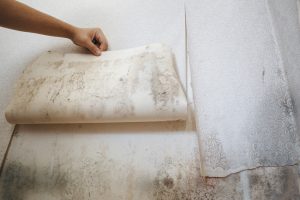
Mold is a type of fungi that is constantly present in the natural environment. The spores naturally exist in the air inside and outside of your home. In nature, mold plays a key role in decomposing debris and its spores are largely harmless. Indoors, however, mold can become a problem if its spores discover moisture and a food source. With these two things, mold spores have what they need to grow and become an issue.
Mold growth can jeopardize a building’s structure. Oftentimes, mold grows on building materials and uses them as a food source, which weakens the materials. Additionally, mold may present health concerns to inhabitants, causing allergies and other irritations. For people who have asthma and weakened immune systems, mold can be even more hazardous to their health. Knowing this, it’s best for property owners to seek immediate assistance for mold removal once discovered. Professionals will address the mold growth and eliminate the fungi effectively from your property.
When dealing with mold growth, there’s a five-step mold remediation process that many professionals follow. This process is detailed below.
Step 1: Inspect for Mold
If you find black spotting or splotches on your walls, this is an indication that there’s mold. You can also smell mold, as mold gives off a musty odor. Sudden allergic symptoms, such as breathing issues and sneezing, may be a sign that there’s mold growth present in your property. If there’s any water damage within your property, then the affected areas can be sites of mold growth, as such areas provide the necessary conditions for mold to thrive.
If you find evidence of or suspect mold growth, you’ll need to get a professional mold inspection done. Mold testing will be done to figure out the extent of mold growth via direct surface testing and air quality testing. To accomplish this, professionals use infrared cameras and other advanced instruments and equipment. This allows them to find all sources of mold growth — even if hidden behind walls.
Once testing is complete, air and surface samples are sent for evaluation at a laboratory where a report is created.
Step 2: Take Care of the Moisture
Moisture is one of the key needs for mold growth, so if an area is dry, then mold cannot grow on it. As such, you need to eliminate any moisture in your home, taking care of it from its source. There are various moisture sources to consider, such as leaky pipes or faulty fixtures. Appliances, like a clothes dryer, should be vented to the outside so that the moisture can escape from your home. You can also control the humidity levels of your property to help limit the moisture inside, maintaining levels between 30 and 50 percent.
Step 3: Contain the Damage
When there’s mold damage, it’s important to contain it. Otherwise, there’s a risk of the mold spreading further. Professionals will contain the damage, using plastic barriers to protect unaffected areas. Negative air pressure forces mold spores in the air to remain in the sealed areas. Any and all fans, as well as the HVAC system, should be turned off. This is so the potential spreading of mold is limited.
Although there are various home remedies one can take to eliminate mold, such measures are not recommended for large cases of mold, because it’s much easier for the mold to spread and for the problem to worsen. Plus, these do-it-yourself methods don’t ensure the fungus won’t return.
Step 4: Remove the Mold
Professional technicians remove drywall or carpeting contaminated with the fungus. To conduct mold removal, affected areas are treated with antifungal commercial grade antimicrobials. Any materials and porous surfaces that cannot be removed are treated, too, to ensure mold is completely eliminated. This treatment prevents the mold from spreading and new mold from developing. Professionals also use biocides on nonporous surfaces and objects. Places where biocides are often applied are in bathrooms and on countertops, sinks, and tiles.
Step 5: Disinfect the Property
Even after the mold has been removed, it is important to thoroughly disinfect the property to ensure the complete removal of mold. Affected objects are cleaned, and items that have been badly damaged by the mold are replaced. If walls were affected by mold, they are repainted with specialized paint that inhibits future mold growth.
If you find mold growth within your home or business, this is an issue you need to take seriously. Not only does mold look bad, but it also jeopardizes the structural integrity of the property and may cause health problems for anyone who inhabits the space. You don’t want to risk further damage and issues, so it’s important to immediately seek help for the mold.
ServiceMaster Kwik Restore provides mold remediation services to help residential and commercial properties eliminate mold. Within our services, we use advanced cleaning procedures to safely conduct mold testing, mold removal, and restoration/replacement of damaged goods and materials.

